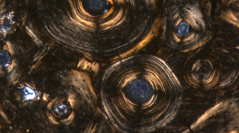

 Comptes Rendus Palevol
15 (1-2) - Pages 23-31
Comptes Rendus Palevol
15 (1-2) - Pages 23-31Identification and interpretation of bone tissue types is the primary goal of histological analysis. Lamellar bone, a fundamental tissue, is generally easily identifiable in polarized microscopy. It is important, however, to understand the formation and structure of the tissues that are being studied. Lamellae are widely accepted to form a plywood-like structure, but this hypothesis has been and continues to be contested. Here, we discuss the common interpretations provided by the scientific community as to the spatial organization of lamellar bone. The two major competing hypotheses, lamellae that have alternating tissue compositions versus lamellae that alternate in fiber orientation, are described. In addition, recent research has led to a confounding array of interpretations of lamellae, with several authors viewing the thickness, orientations and composition of lamellae differently. We conclude that a blended approach is needed, as the varying methods are not easily comparable to one another. With an integrated approach, lamellae can be better understood, improving interpretations, including histological ones.
Lamellar bone, Collagen fiber orientation, Heterogeneous lamellae